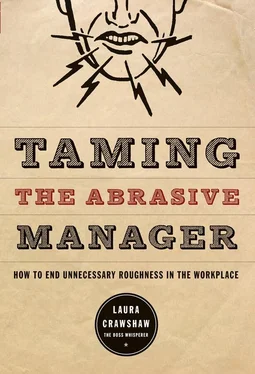Laura Crawshaw - Taming the Abrasive Manager
Здесь есть возможность читать онлайн «Laura Crawshaw - Taming the Abrasive Manager» — ознакомительный отрывок электронной книги совершенно бесплатно, а после прочтения отрывка купить полную версию. В некоторых случаях можно слушать аудио, скачать через торрент в формате fb2 и присутствует краткое содержание. Жанр: unrecognised, на английском языке. Описание произведения, (предисловие) а так же отзывы посетителей доступны на портале библиотеки ЛибКат.
- Название:Taming the Abrasive Manager
- Автор:
- Жанр:
- Год:неизвестен
- ISBN:нет данных
- Рейтинг книги:3 / 5. Голосов: 1
-
Избранное:Добавить в избранное
- Отзывы:
-
Ваша оценка:
- 60
- 1
- 2
- 3
- 4
- 5
Taming the Abrasive Manager: краткое содержание, описание и аннотация
Предлагаем к чтению аннотацию, описание, краткое содержание или предисловие (зависит от того, что написал сам автор книги «Taming the Abrasive Manager»). Если вы не нашли необходимую информацию о книге — напишите в комментариях, мы постараемся отыскать её.
Taming the Abrasive Manager — читать онлайн ознакомительный отрывок
Ниже представлен текст книги, разбитый по страницам. Система сохранения места последней прочитанной страницы, позволяет с удобством читать онлайн бесплатно книгу «Taming the Abrasive Manager», без необходимости каждый раз заново искать на чём Вы остановились. Поставьте закладку, и сможете в любой момент перейти на страницу, на которой закончили чтение.
Интервал:
Закладка:
But the pain of work itself is not the pain I’m addressing in this book. Nor am I talking about the pain caused by bosses who cut programs, pay, or people based on business need. I’m talking about the pain suffered from direct contact with an abrasive boss; the emotional wounds sustained from direct interpersonal aggression experienced in day-to-day interactions with abrasive bosses. And the suffering isn’t limited to abrasive bosses’ subordinates: all of their coworkers—subordinates, peers, and superiors alike—can be rubbed raw by the grinding force of disrespectful treatment:
‘‘He’s always talking down to people, interrogating them—‘Why didn’t you do this? Why didn’t you do that?’—he makes people feel like idiots.’’
‘‘Everyone feels helpless, hopeless, out of control.’’
‘‘She does what’s best for her—she doesn’t stand up for us, ever. If she’s questioned by management, she comes back and attacks without exploring the issue.’’
‘‘It leaves us feeling so unimportant—like we’re not worth anything.’’
‘‘We’re all afraid of him; he walks around, sees something that sets him off and starts yelling. It gets so tense—to the point where no one wants to even talk. It’s getting harder to come to work.’’
‘‘The best days at work are the days she isn’t here—that’s when we can breathe.’’
‘‘Working here reminds me of the time I was in an abusive relationship. I find myself thinking ‘What’s wrong with me? What am I doing wrong? What can I do differently?’ I’ve never had that experience in my work life until this new manager showed up.’’
‘‘I used to enjoy coming to work, but since she’s been here, all I can think about is finding a way to get out.’’
‘‘He’s not a team player. It’s never ‘we’; it’s always ‘I want,’ ‘I said.’ ’’
‘‘When he shows up, we shut up. We don’t tell him any more than we have to because you don’t want to bring up anything that will provoke him.’’
‘‘Her behavior shouldn’t be tolerated. We shouldn’t have to constantly walk on eggshells.’’
‘‘People get a sick stomach when he walks through the department.’’
‘‘It all boils down to respect—when you feel your efforts are appreciated, when you see some interest in what you’re doing, that’s respect. I can’t deal with the contempt, the ugly mood swings, his refusal to treat his team with respect.’’
To Kick or Not to Kick
The suffering caused by abrasive bosses is not only injurious, it’s also inefficient. Typically, at the outset of coaching, my abrasive clients will argue this point, insisting that unless they ‘‘kick ass,’’ the work won’t get done. In his landmark article ‘‘One More Time: How Do You Motivate Employees?’’ renowned management researcher Frederick Herzberg (1968) termed this the KITA (kick-in-the-you-know-what) approach to management. However, the KITA approach presents certain drawbacks. Herzberg listed the limitations of physically kicking one’s coworkers:
(1) it is inelegant; (2) it contradicts the precious image of benevolence that most organizations cherish; and (3) since it is a physical attack, it directly stimulates the autonomic nervous system, and this often results in negative feedback—the employee may just kick you in return [p. 54].
Physical KITA and psychological KITA appear to be equally ineffective in building internal motivation:
Why is KITA not motivation? If I kick my dog (from the front or the back), he will move. And when I want him to move again, what must I do? I must kick him again. . . . But it is only when one has a generator of one’s own that we can talk about motivation. One then needs no outside stimulation. One wants to do it [p. 55].
Abrasive bosses manage for movement rather than motivation. They are blind to the fact that external intimidation does nothing to build internal motivation; they are blind to the reality that employees respond more positively to carrots than sticks. Abrasive bosses flog their coworkers into movement, whereas insightful (or what I will term adequate ) bosses use positive strategies to make their employees want to move. They rely on the carrots of positive reward, unwilling to resort to psychological horsewhippings. And in the rare instances where employees refuse to move at the required pace, adequate bosses understand that beating a nearly dead horse is not only cruel—it’s also inefficient. Instead, they cut the employee from the herd through the civilized processes of formal termination. Abrasive bosses approach motivation very differently, and in the next chapters we’ll be looking at how, when, and why abrasive bosses kick their coworkers.
Speaking of motivation, you may be wondering what motivates me to coach abrasive bosses. I’m going to confess something that I never reveal to prospective corporate clients. Ready? My mission is to reduce suffering in the workplace. I dare not speak of this mission when I talk with companies struggling with an abrasive boss—it absolutely reeks of touchy-feely. I don’t want these hard-nosed business folks to suspect that they’re hiring a bleeding-heart social worker, do I? Social service types are highly suspect in the work world; we’re perceived as do-gooders intent on disrupting hard business objectives with the ‘‘soft’’ stuff of putting individual needs over organizational objectives. Woody Allen once described a nightmare in which he was pursued by a monster with the body of a crab and the head of a social worker. My body is quite human, but I spare my corporate clients the prospect of any such do-gooder nightmares by concealing my mission and instead making the case for coaching in a language they understand: facts and numbers.
The Costs of Abrasion
Let’s ignore the soft stuff for a moment and take a hard look at the scope and costs of organizational disruption caused by abrasive bosses. For those of you who need numbers, I offer these: A Gallup study of 2 million workers at 700 companies found that poor supervisory behavior was the main reason that employees quit or were less productive (Work & Family Connection, 2005). A study of superior-to-subordinate aggression in the United Kingdom concluded that close to 2.5 million UK employees considered themselves to have been victims of managerial aggression in the previous six months (Hoel & Cooper, 2000). Research conducted by the Center for Creative Leadership (Lombardo & McCall, 1984) reported that 74 percent of successful executives in three Fortune 100 corporations said they had had at least one intolerable boss, and another study (Spherion Corporation, 1999) showed that employees are four times more likely to leave bosses who are not considered ‘‘nice’’ (another word rarely used in a business context). Attrition of valued employees is just one of the prices paid. In the past decade researchers have explored other costs incurred by abrasive bosses: decreased morale and motivation resulting in absenteeism and lowered productivity (McCarthy, Sheehan, & Kearns, 1995), higher incidence of stress-related illnesses (Quine, 1999) and substance abuse (Richman, Rospenda, Flaherty, & Freels, 2001), increased number of legal actions alleging a hostile environment or discriminatory behavior (Leymann, 1990), and retaliatory responses, including sabotage (Laabs, 1999) and homicide (McLaughlin, 2000; Rayner, 1997).
Had enough? Do I really need to swamp you with more statistics to convince you that abrasive bosses take a serious toll on both employee and employer? Employers not only lose employees; they lose hundreds of thousands of hours of productivity while workers focus on the pain of abrasion instead of the tasks at hand. Think for a moment—how many hours have you seen coworkers spend around the coffee machine or behind closed doors processing the latest painful run-in with an abrasive boss? I have yet to see any formal research on the number of hours management (including human resource staff) devotes to abrasive boss-related issues, but those I have spoken with resent the ‘‘waste’’ (their word) of time that could be better spent on other concerns. I could devote many more pages to documenting the costs incurred by abrasive bosses, but the fact that you are reading this book suggests that you don’t need to be convinced—I suspect you’ve already paid a price.
Читать дальшеИнтервал:
Закладка:
Похожие книги на «Taming the Abrasive Manager»
Представляем Вашему вниманию похожие книги на «Taming the Abrasive Manager» списком для выбора. Мы отобрали схожую по названию и смыслу литературу в надежде предоставить читателям больше вариантов отыскать новые, интересные, ещё непрочитанные произведения.
Обсуждение, отзывы о книге «Taming the Abrasive Manager» и просто собственные мнения читателей. Оставьте ваши комментарии, напишите, что Вы думаете о произведении, его смысле или главных героях. Укажите что конкретно понравилось, а что нет, и почему Вы так считаете.












